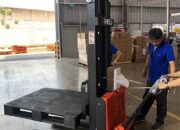A Comprehensive Guide to Choosing the Right Forklift for Your Business Needs
The transportation and storage of goods plays a crucial role in the production and business activities of every enterprise. To optimize this process, forklifts have become an indispensable and powerful tool.
The Importance of Choosing the Right Forklift for Your Business
Forklifts play a vital role in improving labor productivity, minimizing labor costs, and ensuring the safety of goods. Choosing the right forklift not only meets current operational needs but also affects the long-term operational efficiency of the business.
- Increased labor productivity: Reduces transportation time, loading and unloading of goods, increasing work efficiency.
- Cost savings: Reduces labor costs, fuel consumption, maintenance, and repair expenses.
- Safety assurance: Minimizes the risk of occupational accidents and damage to goods.
- Space optimization: Choosing a forklift suitable for the warehouse space helps to utilize the area effectively.
Conversely, choosing the wrong type of forklift can lead to:
- Fuel waste: A forklift that is too large for its intended use consumes more fuel.
- Costly maintenance: Forklifts that are not suitable for the working environment are prone to damage, leading to costly repairs.
- Reduced efficiency: Forklifts that do not meet job requirements reduce labor productivity.
- Safety hazards: Unsuitable forklifts can cause occupational accidents and damage to goods.
Factors to Consider When Choosing a Forklift for Your Business
To choose the most suitable forklift, you need to carefully consider the following factors:
1. Usage Needs:
- Purpose of use: You need to clearly define the purpose of using the forklift: lifting and lowering goods in the warehouse, transporting goods between areas, loading and unloading goods onto trucks, or using it in special environments such as cold storage, manufacturing plants, etc.
- Frequency of use: Will the forklift be used frequently or infrequently? If used continuously with high intensity, you need to choose a model with high durability and a powerful engine.
- Working environment: Is the forklift’s working environment indoors or outdoors? Is the terrain flat or rough? Are there any special requirements for emissions and noise?
2. Characteristics of Goods:
- Type of goods: You need to determine the type of goods to be lifted: pallets, packages, rolls of paper, construction materials, etc. Each type of goods will require a different type of lifting frame and vehicle size.
- Weight of goods: Determine the required lifting capacity. It is advisable to choose a forklift with a lifting capacity about 10-20% greater than the actual need to ensure safety and durability for the vehicle.
- Size of goods: The size of the goods affects the type of lifting frame and the size of the vehicle. Bulky goods require forklifts with wide lifting frames and a long wheelbase.
3. Operating Space:
- Lifting height: Determine the maximum height required to lift and lower goods to select a forklift with an appropriate lifting height.
- Aisles: The width of the aisles affects the size of the vehicle. Narrow aisles require compact forklifts with a small turning radius.
- Turning radius: The smaller the turning radius, the easier it is for the forklift to move in tight spaces.
- Terrain: Flat, rough, sloping terrain or obstacles will affect the choice of forklift type and tire type.
4. Power Source:
Electric Forklifts:
- Advantages: Smooth operation, no environmental pollution, suitable for indoor working environments, cold storage, food production factories.
- Disadvantages: Operating time depends on battery capacity, higher initial investment cost.
Diesel/Gas Forklifts:
- Advantages: Powerful, continuous operation, suitable for outdoor working environments, heavy-duty tasks.
- Disadvantages: Exhaust fumes cause environmental pollution and engine noise is loud.
5. Additional Features:
- Special lifting frames: Double lifting frames, free lifting frames, rotating lifting frames, etc., to meet the needs of lifting special goods.
- Attachments: Roll clamps, buckets, side shifters, rotating forks, etc., expand the application capabilities of the forklift.
- Safety technology: Automatic braking system, overload warning, reversing camera, stability control system, etc.
6. Budget:
- Purchase cost: Consider new or used forklifts. New forklifts are more expensive but ensure quality and performance.
- Operating costs: Include fuel costs, maintenance, and repairs. Electric forklifts have lower operating costs than diesel/gas forklifts.
- Labor costs: Forklift training and operation.
Common Types of Forklifts
Here are some common types of forklifts on the market:
1. Counterbalance Forklifts:
- Classification: Electric forklifts, diesel/gas forklifts.
- Advantages: Versatile, high load capacity, suitable for many types of goods and working environments.
- Disadvantages: Large turning radius, not suitable for narrow spaces.
2. Reach Trucks:
- Advantages: Suitable for narrow spaces, high lifting height, highly efficient in loading and unloading goods in high-rise warehouses.
- Disadvantages: Limited lifting capacity, higher price compared to counterbalance forklifts.
3. Hand Pallet Trucks:
- Advantages: Low price, easy to use, suitable for lifting light goods, moving short distances.
- Disadvantages: Low lifting capacity, manual movement, low work efficiency.
4. Aerial Work Platforms:
- Classification: Scissor lifts, boom lifts.
- Advantages: Lift people to work at height, safe and efficient.
- Disadvantages: Not used to lift goods, high price.
Choosing a Reputable Supplier
Choosing a reputable supplier is just as important as choosing the right forklift. A reputable supplier will ensure product quality, good after-sales service, and reasonable prices.
When choosing a supplier, you need to pay attention to the following points:
- Experience and reputation: Choose a supplier with many years of experience in the forklift field, with a good reputation in the market.
- Product quality: Ensure that the product has a clear origin, and the quality meets standards.
- After-sales service: Warranty, maintenance, repair, and spare parts supply.







